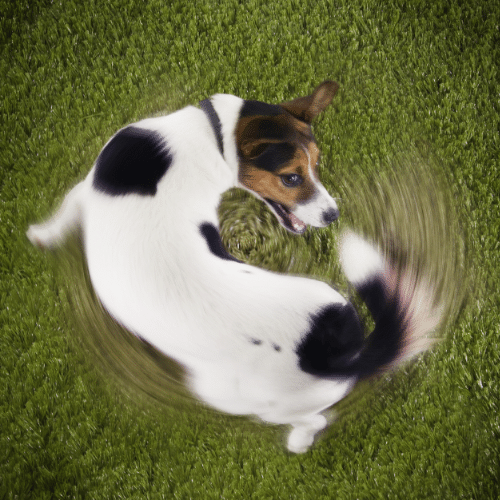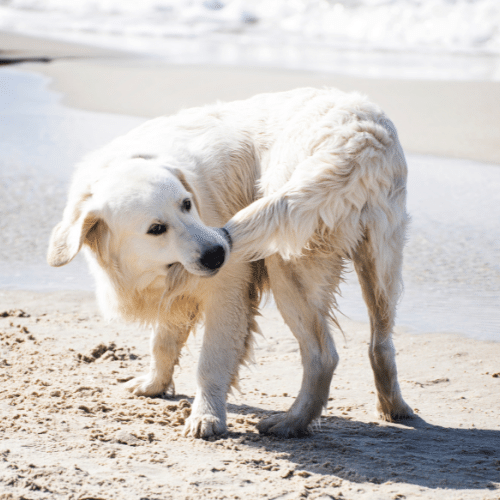Should I Let My Dog Chase His Tail?
August 7, 2021 2021-08-08 19:28Letting a dog chase their tail is a bit of a complicated subject. Stereotypically, dogs do chase their tails. It’s a funny and entertaining behavior for most people, but they typically don’t think about it any more than that.
In most cases, dogs chase their tail for completely innocent reasons. Often, they may simply be bored. There is little reason to stop them in these cases. Some intelligent dogs may learn that people pay attention to them when they chase their tails. Again, this is pretty innocent behavior.
However, there are other occasions where a dog chasing their tail isn’t just “cute.” It can be a sign of an underlying problem. While your dog chasing their tail typically isn’t the actual problem, it may be a sign that you need to take care of something else in your dog’s life. For instance, infections can cause dogs to chase their tails, as it will likely be quite itchy.
Some dogs will exhibit compulsive tail-chasing. While this isn’t always a problem, it absolutely can be. Many dogs with this compulsive problem also have other compulsive problems that can be more of an issue.
Basically, a dog chasing its tail typically isn’t a problem in itself. However, it may indicate an underlying problem.
Table of Contents

Should I Stop My Dog from Chasing His Tail?
Typically, there is no reason to intervene when a dog chases their own tail. There usually isn’t any harm that comes out of the tail-chasing behavior. While dogs may look like they get a bit aggressive, most of them do not actually harm their own tail.
In most cases, we recommend letting the tail-chasing continue. Most dogs do it out of boredom. They’re basically using their tail as a toy. If you’re concerned, you can offer them some appropriate toys, but many dogs will simply enjoy using their tail more. This seems to be the case most prominently with younger dogs, who tend to be more playful.
Other dogs learn that when they chase their tail, humans tend to pay attention to them. Many people view this behavior as cute, and it can absolutely get your attention. Therefore, they may chase their tail when they want you to pay attention to them. This is most common in more intelligent breeds, as it does take some intelligence to figure out this cause-and-effect relationship.
With that said, there are a few not-so-benign reasons that a dog may chase their tail. While tail chasing is likely never going to be the problem, it may help bring your attention to some problems that do need to be treated. Again, the tail-chasing itself is never going to be an issue. However, it can indicate an underlying problem.

1. Zinc Malabsorption
Zinc is an important mineral for dogs and humans alike. It is linked closely with how cells function, as it is necessary for the body to use many of the different essential fatty acids. It is particularly important for skin health, as these cells are constantly being shed and replaced.
However, some breeds are prone to conditions that make it difficult for their body to absorb zinc. The Bull Terrier is one of the most common breeds with this genetic condition. Copper is usually also lower in Bull Terriers affected by this condition.
Usually, the puppies with this condition fail to thrive and do not survive for very long. However, not all dogs show serious symptoms of this disease. There have yet to be studies that reveal why some dogs are heavily affected by these genetic conditions and why others are not.
In fact, in some cases, the dogs don’t actually show any symptoms of a zinc deficiency – except tail chasing. In this occurrence, the tail chasing is due to a disorder in the brain, which may be caused by zinc deficiency. Often, these dogs chase their tails and later develop other neurological conditions. Some show strange and sudden personality changes, like aggression.
2. Tail Infections
Most breeds of dogs are not prone to tail infections. However, in breeds with corkscrew tails, infections can occur. Their tails are simply so curled up that moisture can get stuck in small pockets, which can encourage bacterial growth. When it becomes infected, it may become very itchy, which can cause tail chasing.
However, you can usually distinguish this from other forms of tail chasing, as the dog will be fixing an itch, not playing.
Luckily, this condition is completely treatable. Usually, antibacterial medications and creams are prescribed.
If this happens just once in a dog’s life, it usually isn’t much of a problem. However, it can reoccur continuously in some dogs. Their tails are just prone to holding onto moisture, or it could be their environment. In places that are higher in humidity, tail infections may be more common. If your dog’s tail keeps getting infected, it may need to be amputated.
Once again, this typically only occurs in dogs with corkscrew tails. A dog with a long, normal tail isn’t going to get any moisture build-up and, therefore, won’t get a bacterial skin disease. However, scratches and sores by the tail may get infected, which can cause similar itchiness. Usually, though, these dogs do not need their tails amputated, as it won’t be a reoccurring problem.
3. Compulsive Behaviors
While tail chasing is usually thought to be harmless, one study has found that it may be a sign of an underlying mental condition in some cases. According to the study, about one-third of dogs who were chasing their tails showed other clinical signs of obsessive behaviors. These signs are observed across all breeds, so it isn’t something that is genetically related.
Furthermore, most tail-chasing seems to occur most often indoors with a TV switched on. It may be that these dogs are overstimulated, bored, or under-exercised, which can also prompt tail chasing. Herding dogs, shepherds or other high-strung dogs such as Huskies can be especially prone to that.
If your dog is chasing their tail to the point of missing out on other activities, it could be a sign of a problem. Most dogs will stop chasing their tail when offered another activity, like a toy. If your dog does not, it may be a compulsive behavior. Your dog may even injure their tail, which can then become infected.
Often, older dogs are most prone to their behavior. It is a sign of a declining mental state, where the dog may not realize that they are even chewing on their tail. However, this can cause skin irritation and infections, which older dogs may be more prone to.
Compulsive behavior can often give way to other behavioral changes. Aggression and similar problems are more common in dogs with OCD behaviors. This could be because the compulsive behaviors are caused by an underlying problem, which will go on to further cause behavioral changes if the dog is not treated. Zinc deficiency is one such underlying problem, which we discussed earlier.
Should I Be Worried If My Dog Chases Their Tail?
Some dogs are simply more prone to chasing their tail than others. Tail chasing becomes a common way that they keep themselves entertained. In these cases, you usually don’t have much to be worried about.
If your dog suddenly starts chasing their tail, you may need to look into it a bit more. We recommend offering your dog other activities and increasing their mental and physical stimulation. Increase the amount of playtime provided and try some puzzle toys. If these don’t decrease the amount of tail chasing, there could be an underlying problem. A visit to your vet is likely called for.
If your dog has a screw tail, you should check its tail for signs of infections. Redness, swelling, and discharge are all common infection signs. However, just because you don’t see these signs doesn’t mean that your dog’s tail isn’t infected. The infection may be in a deep pocket that is difficult for you to see. A visit to your vet may still be called for.

You may particularly want to seek out vet attention if your dog is a Bull Terrier or a similar breed. These dogs are prone to genetic conditions that may cause tail chasing. While the tail chasing isn’t itself a problem, the underlying conditions will need to be treated.
Conclusion
Tail chasing itself isn’t that much of a problem. Your dog typically won’t injure themselves, though there is always the possibility that they will bite their tail a bit too much. However, it can indicate an underlying problem that may need treatment.
We recommend seeking vet attention if you are concerned about your dog’s tail-chasing. Your vet may find no need for concern, but this will rule out whether or not your dog has any underlying problems. If your dog suddenly starts chasing their tail and doesn’t respond when you offer other activities, we highly recommend seeking vet attention.
Once the root of the problem has been treated, the tail-chasing will likely diminish.

Author: Kristin
Kristin was born in Tennessee and currently lives there with her husband and children. She is passionate about educating pet parents and helping them make the best possible decisions for their pets. She currently owns one dog, two cats, a lizard, and a variety of fish.

